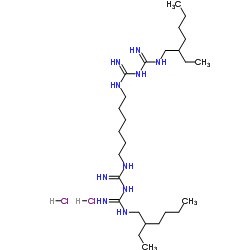Alexidine dihydrochloride

Alexidine dihydrochloride structure
|
Common Name | Alexidine dihydrochloride | ||
|---|---|---|---|---|
| CAS Number | 1715-30-6 | Molecular Weight | 581.712 | |
| Density | 1.1g/cm3 | Boiling Point | 658.2ºC at 760mmHg | |
| Molecular Formula | C26H58Cl2N10 | Melting Point | 220.6-223.4ºC | |
| MSDS | Chinese USA | Flash Point | 351.8ºC | |
| Symbol |

GHS07 |
Signal Word | Warning | |
|
Chemical interaction of alexidine and sodium hypochlorite.
J. Endod. 38(1) , 112-6, (2012) Recent studies have reported the color change and formation of precipitates containing para-chloroaniline (PCA) after a reaction of sodium hypochlorite (NaOCl) and chlorhexidine (CHX). Alexidine (ALX), a biguanide disinfectant similar to CHX, has greater affi... |
|
|
Quantitative high throughput screening using a primary human three-dimensional organotypic culture predicts in vivo efficacy.
Nat. Commun. 6 , 6220, (2015) The tumour microenvironment contributes to cancer metastasis and drug resistance. However, most high throughput screening (HTS) assays for drug discovery use cancer cells grown in monolayers. Here we show that a multilayered culture containing primary human f... |
|
|
Pan-antimicrobial failure of alexidine as a contact lens disinfectant when heated in Bausch & Lomb plastic containers: implications for the worldwide Fusarium keratitis epidemic of 2004 to 2006.
Eye Contact Lens 38(4) , 222-6, (2012) ReNu with MoistureLoc (ReNuML), containing the antimicrobial agent alexidine 0.00045%, was associated with the Fusarium keratitis epidemic of 2004 to 2006. Although a single-point source contamination was ruled out, only Fusarium organisms were reported durin... |
|
|
Amoebicidal activities of alexidine against 3 pathogenic strains of acanthamoeba.
Eye Contact Lens 35(1) , 1-5, (2009) Effective pharmacotherapy for Acanthamoeba keratitis has been hampered because of the marked resistance of various stains to a variety of antimicrobial agents. In view of the fact that topical Brolene (propamidine isethionate) and neosporin are currently cons... |
|
|
Mechanism of drug failure in fusarium keratitis, 2004-2006.
N. Engl. J. Med. 370(1) , 88-9, (2014)
|
|
|
Alexidine and chlorhexidine bind to lipopolysaccharide and lipoteichoic acid and prevent cell activation by antibiotics.
J. Antimicrob. Chemother. 62(4) , 730-7, (2008) Many antibiotics used to treat infections cause release of immunostimulatory cell wall components from bacteria. Therefore, a combination of antimicrobial and endotoxin-neutralizing activity is desired to prevent inflammation induced by destroyed bacteria. Ch... |
|
|
A comparative study of the bactericidal and growth inhibitory activities of the bisbiguanides alexidine and chlorhexidine.
J. Appl. Bacteriol. 66(3) , 243-52, (1989) A comparative study of the growth inhibitory and bactericidal activities of two related bisbiguanide antiseptics, alexidine and chorhexidine is reported. Whilst overall bactericidal activities and MICs were similar, alexidine was more rapid in its action and ... |
|
|
Cationic antiseptics: diversity of action under a common epithet.
J. Appl. Microbiol. 99(4) , 703-15, (2005)
|
|
|
Antimicrobial effect of alexidine and chlorhexidine against Enterococcus faecalis infection.
Int. J. Oral Sci. 5(1) , 26-31, (2013) A previous study demonstrated that alexidine has greater affinity for the major virulence factors of bacteria than chlorhexidine. The aim of this study was to compare the antimicrobial activity of 1% alexidine with that of 2% chlorhexidine using Enterococcus ... |
|
|
Effect of Chinese and western antimicrobial agents on selected oral bacteria.
J. Dent. Res. 61(9) , 1103-6, (1982) The susceptibility of selected oral bacteria, including suspected periodontopathogens, to a commonly employed Chinese herbal medicine Huang-chin (HC, Scutellaria baicalensis) was tested in vitro. The minimum inhibitory concentration (MIC) and minimum bacteric... |